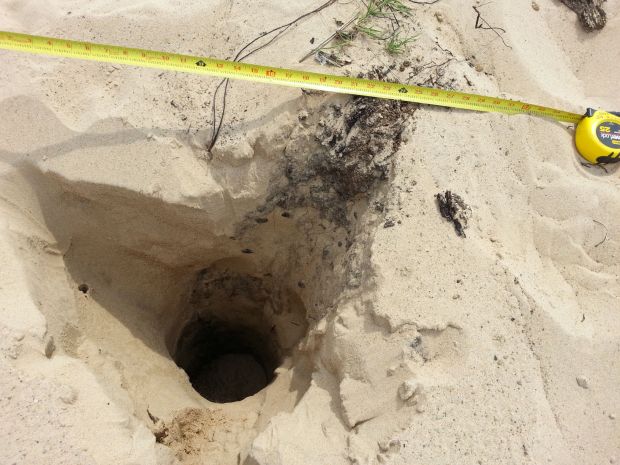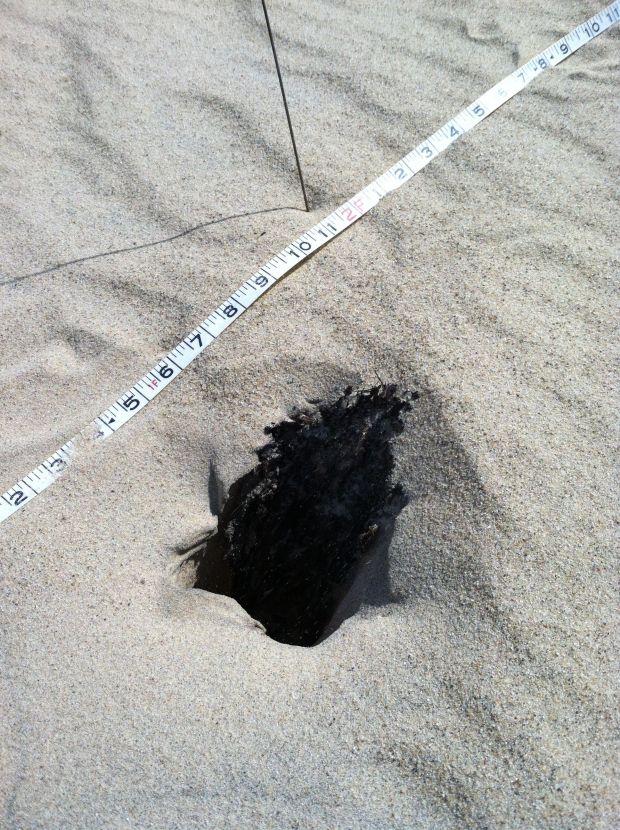
© Provided by Indiana Dunes National LakeshoreScientists do not know what caused this hole and others to appear in Mount Baldy at the Indiana Dunes National Lakeshore since last summer. Additional research will be conducted this summer and may last into the fall. To ensure the public's safety, Mount Baldy, its parking lot, trail, and beach in front of the dune will remain closed to all vehicular and pedestrian access while the investigation continues.
Michigan City, Indiana - Officials at Indiana Dunes National Lakeshore announced Thursday that scientists still do not know what caused holes to appear in Mount Baldy last summer, and the popular attraction will remain closed for further study.
Nathan Woessner, 6, of Sterling, Ill., was swallowed by a hole July 12 and rescued by firefighters.
Two additional holes have appeared since July, park officials said Thursday.
Ground penetrating radar studies performed by the Environmental Protection Agency have identified a large number of anomalies below the dune's surface, but scientists from the National Park Service, Indiana University and the Indiana Geological Survey still do not know how these holes were formed.
"Mount Baldy is one of the most visited sites in the national lakeshore, attracting thousands of visitors each year" said Acting Superintendent Garry Traynham in a press release. "But the continued development of these holes in the dune surface poses a serious risk to the public. Our first obligation must be to the welfare of our visitors who are here for an enjoyable outing."

© Provided by Indiana Dunes National Lakeshore
The two additional holes and a number of depressions have been found since July. Officials said the holes are short-lived, remaining open for less than 24 hours before collapsing and filling in naturally with surrounding sand.
Officials at the national lakeshore on Thursday announced more testing will be conducted this summer. That work will include mapping of openings and depressions, as well as scientific studies of the internal architecture of the dune.
Park workers will continue planting marram grass on portions of Mount Baldy where the native dune grass used to grow. The extensive root system of the grass holds sand in place and may also help prevent holes from opening up on the dune's surface, officials said.
All other beach access areas within the national lakeshore remain open.
Comment: 
Oregon Dunes "tree holes"
I've run into holes like these while hiking across the
Oregon Dunes. One explanation for the holes is that ancient trees that were buried by the sand that decomposed sometimes leave these deep, narrow holes and the holes can persist, under a layer of sand for a very, very long time. I stepped onto such a patch of sand and the sand gave way and I was suddenly in sand up over my knee. When I pulled my foot out and looked down the hole I could not see the bottom. I think I joked to my hiking partner about the holes being created by
baby sandworms (the author of
Dune, Frank Herbert, said he
came up with the original idea for the novel while hiking in the Oregon dunes.) I actually found a reference in another locally-inspired novel that might have even specifically referred to one kind of dune tree hole:
In
Sometimes a Great Notion, Ken Kesey's fictional novel about a rough logging town on the Oregon coast, a character walking in the dunes at night plummets into the shaft of a buried hollow tree - called a devil's stovepipe.
About "tree holes" in the dunes
About the Oregon Dunes & Frank Herbert connection





Comment:
I've run into holes like these while hiking across the Oregon Dunes. One explanation for the holes is that ancient trees that were buried by the sand that decomposed sometimes leave these deep, narrow holes and the holes can persist, under a layer of sand for a very, very long time. I stepped onto such a patch of sand and the sand gave way and I was suddenly in sand up over my knee. When I pulled my foot out and looked down the hole I could not see the bottom. I think I joked to my hiking partner about the holes being created by baby sandworms (the author of Dune, Frank Herbert, said he came up with the original idea for the novel while hiking in the Oregon dunes.) I actually found a reference in another locally-inspired novel that might have even specifically referred to one kind of dune tree hole:
In Sometimes a Great Notion, Ken Kesey's fictional novel about a rough logging town on the Oregon coast, a character walking in the dunes at night plummets into the shaft of a buried hollow tree - called a devil's stovepipe.
About "tree holes" in the dunes
About the Oregon Dunes & Frank Herbert connection